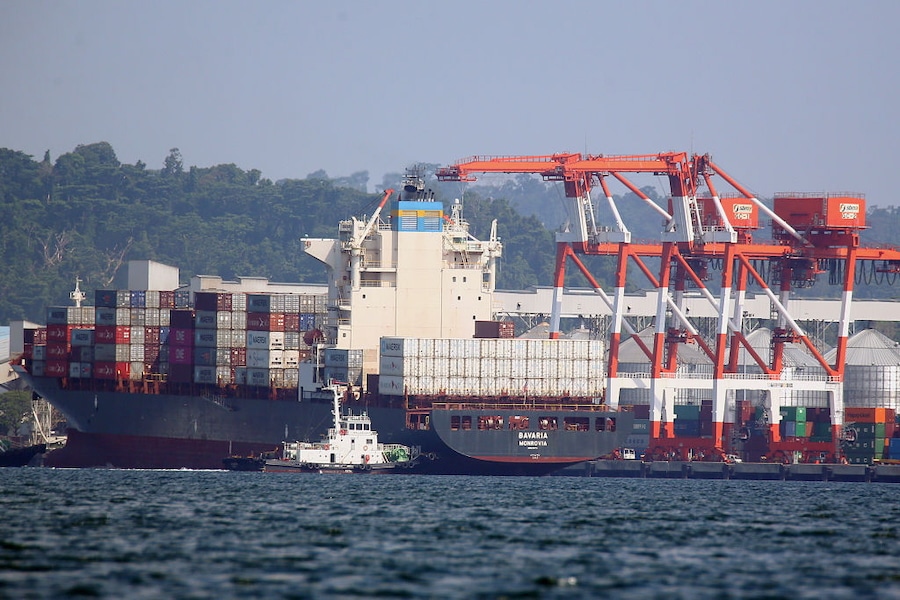This post was originally published on Eco Watch
In 2018, China made global headlines when it banned the importation of foreign plastic and electronic waste. This fleeting news item exposed one of the dirty secrets of the Western world’s trash – that much of our garbage is, in reality, shipped elsewhere, many times under the shield of “recycling,” a little-known fact until China’s ban made headlines.
Once the world’s biggest importer of plastic waste, China shut the doors on this huge industry. But did the waste disappear? Did the overall quantity of waste decrease? The brutal answer is no.
In his astonishing and sobering new book Waste Wars: The Wild Afterlife of Your Trash, Alex Clapp summarizes what rich Western countries did next:
Many just located desperate new buyers — or unguarded borders — and continued to insist that it was getting recycled. Within months, Greek garbage started surfacing in Liberia. Italian trash wrecked the beaches of Tunisia. Dutch plastic overwhelmed Thailand. Poland would be forced to charter a special police unit to patrol for waste getting trucked in from Germany, while French cops who had once busied themselves with checking the fenders of cars arriving from neighboring Belgium for heroin became tasked instead with inspecting trunks for bags of garbage.

The consumer trade – and its attendant waste and recycling trade – is enormous. It is estimated that the global trade in waste is larger than global weapons, timber and wheat trades combined. And not only is the waste trade huge and growing, it is only borderline legal in most places. While a country like Thailand enacted an admirable ban on plastic waste starting in 2025, many other countries have not. Recycling and waste are the backbone of the 21st century consumerist economy. Without the blue bins, Coke bottles would have nowhere to go. Without the ability to “recycle” an old and slow smartphone, it becomes less viable to purchase new electronics.
Clapp’s book delivers a knockout blow to the idea of recycling. He balances a historical look at consumer and plastic culture with stunning on-the-ground reporting from some of the most toxic places on Earth. He spent two years “living out of a backpack” and going to places like Ghana, Indonesia and Turkey to expose where our waste ends up – and why it’s hidden from view.
Clapp told EcoWatch, “I wanted to write a book that basically explained the question, or attempted to answer the question of when did our trash stop being something that we just discarded and never really thought about again? And when did it become this object of commerce, this object of exchange?”
Dissembling an electronic toy is far too toxic for the Western world, but can be a lucrative enterprise elsewhere, despite the carbon emissions.
“As soon as you attempt to process them, that’s when all the toxicity, that’s when all the contaminants and chemicals start coming out,” Clapp said. “We’re offloading a lot of our manufacturing processes to those places where, frankly, we think it’s fine for them to be contaminated and polluted.”
To start, I asked Clapp where might the plasma TV and the remote controls that I recently brought to my New Jersey e-waste container end up?
“There’s a very good chance that those will end up in a poor country,” he said. “The reason we throw away our electronics is generally because there is something wrong with them. You send that TV to Honduras or to Nigeria, maybe it keeps working for six months, maybe for another year. The way that these materials are broken down in these poorer countries, we knowingly send this stuff to places where we know this stuff will not be handled properly, where all the contaminants, all the nasty material within that television will end up going into local ecosystems, whether it’s the soil, the water or the air. And it does an eternity worth of damage.”
This is the shock of Waste Wars: how much e-waste and plastic waste is foisted onto other countries: out of sight, out of mind. Entire economic ecosystems have been built up to manage this waste trade. One of Waste Wars’ most powerful sections is Clapp’s trip to Ghana where he embeds himself in Agbogbloshie near the center of Ghana’s capital of Accra, observing pickers try to make a living by sifting through mountains of electronic waste.

Young men burning electrical wires to recover copper at Agbogbloshie, Ghana on Sept. 2, 2019. Muntaka Chasant / CC BY-SA 4.0
Here he describes the burning of e-waste to extract the copper wiring:
They had begun by tossing wigs and dried-out coconut shells into multiple conflagrations at once, which crackled and danced and turned emerald green as thick clouds of leaden smoke spewed toward the Onion Market. When the fires grew larger, the burner boys switched to heavier kindling, feeding disemboweled televisions and refrigerator insulation foam into the flames. Every few minutes they used iron rods to lance out chunks of copper, gradually shorn of their PVC plastic encasements, dexterously lassoing the metal around their spear prongs and examining its state.
It’s a remarkable scene, and remarkably toxic in the real world.
“You have a slum of some 40,000 people who exist purely to process electronic waste, some of which again comes from Ghana, but a lot of which is coming from foreign countries,” Clapp said.
Another economy that Clapp followed was paper recycling – again, mountains of paper from Western countries being shipped around the world. He focuses on Java, where, because of loose regulations and lax enforcement at ports, the actual crates purportedly to be full of paper are in fact mixed with plastics from the same parts of the world.

A plastic dump, full of foreign waste, near a paper mill in East Java. Beth Gardiner
“It’s more probable that the plastic is smuggled into these shipments. You go to a place like Java, which theoretically is not taking plastic waste imports anymore,” Clapp said. “And yet, you go deep into the mountains, and you find these towns which are just covered as far as the eye can see, stacked to the knee with secondhand plastic, and none of this is arriving there as plastic per se.”
And what happens to that plastic is even more devastating: it is sold to tofu and cracker factories, who burn the plastic to cook tofu. Clapp writes:
It’s an environmental wrecking ball whose ramifications are becoming more and more incontestable after having occurred each and every day for the last twenty years: Torching plastic Doritos bags to bake one of the staples of your national cuisine is unbelievably dangerous.
Clapp makes it clear that the ones working in these waste industries are not to blame.
“They’re not often thinking about these things in abstract or long-term ways,” he said. “They see trash as fundamentally a commodity. It’s something to make money off of. You and I might go and be horrified by what we would see in a place like Agbogbloshie, but they’re intensely practical about it. And the problem is, I think there’s so much destitution and poverty that they don’t pause to think about these things and sort of loftier ways.”
As one legislative example of how the global waste trade became so massive and corrupted, Clapp cites the waste diversion law passed around 1996 in California that forced 50% of waste to not be disposed of in the state, either through “waste reduction, recycling, or other means.”
“California – one of those places that’s very self-congratulatory about its environmental record – does huge amounts of damage by sending all of this waste to places where, again, we don’t really understand what’s happening to this stuff, but we get to call it all ‘recycling’.”
Clapp devotes a section to shipbreaking in Turkey – not just cruise ships, but aircraft carriers, rusted tugboats, oil rigs. Shipbreaking is a major source of steel recycling, but Clapp relays the tragic story of Oğuz Taşkın, who died doing the incredibly dangerous work of taking ships apart.

And finally, Waste Wars ends up in plastics being shipped around the world. Plastics, of course, are intrinsically difficult to recycle, and yet in the mountains of Indonesia, the population there has almost been forced to deal with Western plastic waste.
“Indonesia is a place where domestically discarded plastic, there’s as much a chance that it ends up in the ocean as it ends up in a landfill,” Clapp said. “And yet somehow in the middle of Java, in the middle of these mountains, you have these towns which are now competing at gunpoint at times over western plastic waste, because there’s money to be made.
“Those contaminants, those toxins are being ingested hourly by great numbers of Indonesians. So, it’s just this really sordid business. And it just goes to show that trash is one of these things where you develop all kinds of derivative economies.”
Ultimately, Clapp sees no end to the trade in waste.
“This is essentially worthless material that’s dangerous and difficult and expensive to get rid of,” he said. “The supply is endless. I mean, look at all this stuff we throw away. If you got into this business, you would never, ever, run out of material to ship. The other thing is, you know, unlike drugs, if you get caught shipping trash, it’s a theoretical slap on the wrist.”
Clapp writes:
In spite of the advances of the green transition — though in large part because of them — we are heading toward a future in which plastic ceases to be the commodified byproduct of our global energy regime and becomes instead the fundamental driver of hydrocarbon extraction.
“One thing I find really interesting is look at the companies that produce a lot of the stuff we use, whether this is Unilever, whether this is Nestle, Coca-Cola, Johnson & Johnson, whoever,” Clapp told EcoWatch.
“These companies are legally obliged to tell us where they source their materials, where the stuff was put together. You know, if you look inside an H&M piece of clothing, I’m sure it’ll say it was made in Bangladesh or wherever. The problem with the waste trade is that there is zero transparency, right where this stuff ultimately ends up, and that’s where the toxic processes happen. No one is obliged to tell us anything, and that’s a great injustice.”
The Western world continues to send its old steel, its worn-out electronics, the plastic toys and plastic wrapping that are either past their shelf-life, or designed to be used only once and thrown away.
“Those countries which are reaping the benefits off of all of these objects increasingly no longer have to deal with the environmental consequences of them,” Clapp said.
He writes:
Products designed to take seconds to consume became the objects of months-long journeys from one side of the world to the other. To attempt to cycle tiny pieces of carbon back into production streams, megatons of carbon would be unleashed shipping them from one continent to another. Communities scattered across the equator with little access to technology or economic mobility or clean water were enlisted to receive broken computers, retired cruise ships, discarded water bottles, for the simple reason that we made too much of it all — then balked at being held accountable for its fate.
The tragedy of the waste trade isn’t that it started happening. It’s that we knew it was wrong and failed to stop it.
The post ‘Waste Wars’: A Conflict With No End in Sight appeared first on EcoWatch.





0 Comments